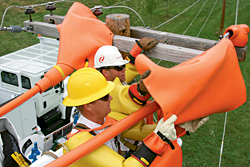Countdown Begins for Small Utilities
Many that do not act now will find it very difficult to comply in time to meet the NESC 2007 requirements.
- By Bill Rieth
- Oct 01, 2006
 THE National Electrical Safety Code® (NESC®) is the standard normally used by electrical utilities when implementing safety procedures for the worker. NESC is also the standard OSHA cites when enforcing utility electrical safety. This standard provides an outline for safeguarding a worker while performing the various tasks that are associated with utility workers.
THE National Electrical Safety Code® (NESC®) is the standard normally used by electrical utilities when implementing safety procedures for the worker. NESC is also the standard OSHA cites when enforcing utility electrical safety. This standard provides an outline for safeguarding a worker while performing the various tasks that are associated with utility workers.
NESC was first written in 1973 and was revised every three years. In 1996, the revision period was increased to four years. Most recently, in 2002, the revision cycle was again lengthened to every five years.
The latest revision, 2007, is now available and includes Flame Retardant (FR) clothing as a requirement. This revision recognizes a history of incidents that have resulted in the ignition of non-FR clothing as a result of arc flash in the utility industry. Because of these incidents NESC added a new rule 410A3, which states, "Effective January 1, 2009, the employer shall ensure that an assessment is performed to determine potential exposure to an electric arc for employees who work on or near energized parts or equipment. If the assessment determines a potential employee exposure greater than 2 cal/cm² exists, the employer shall require the employee to wear clothing or a clothing system that has an effective rating at least equal to the anticipated level of arc energy."
The standard also requires "clothing that will not ignite and continue to burn when exposed to an electrical arc, has an arc rating or ATPV rating at least equal to the level of energy calculated by an arc hazard analysis for the specific job assignment." It goes on to say that clothing made of rayon, polyester, acetate, and nylon shall not be worn at any time.
Those familiar with the NFPA 70E standard will immediately see the similarities between the NFPA 70E requirements and the NESC Rule 410A3. However, beyond the basic requirements of FR clothing and the requirement that employers must perform an arc flash hazard and provide the employee with the proper PPE for the hazard, the two standards begin to differ in their approach.
NESC 2007's Impact on Employers
NESC 2007 includes a series of tables that look similar to the Hazard Risk Category (HRC) tables found in NFPA 70E. The difference is the NFPA 70E tables are sorted based on tasks performed within a voltage range, while the NESC tables are an energy lookup table based on voltage, available fault current, and clearing times.
The NFPA 70E HRC table includes four hazard risk categories with minimum ATPV values (measured in cal/cm²): HRC 1 (4 cal/cm²), HRC 2 (8 cal/cm²), HRC 3 (25 cal/cm²), and HRC 4 (40 cal/cm²). The NESC energy tables include three hazard risk categories. It does not number these categories but does give them minimum exposure values of 4 cal/cm², 8 cal/cm², and 12 cal/cm².
While many larger utilities already provide FR clothing for their employees, there are many small utilities, municipalities, and contractors that will be affected by this standard, both in cost and worker push-back.
Many in the industry believe all FR clothing is hot and uncomfortable to wear. It was true in the past, but today's FR fabrics provide the same comfort as natural-fiber fabrics with complete protection from the thermal exposure brought by an electric arc. Remember that the most severe burns are caused by ignited clothing, not by the original flash fire or electric arc exposure.
The optimal solution would be to wear a properly rated breathable FR garment over a cotton T-shirt. Tests have proven that this type of layering offers the best form of protection when exposed to an arc flash hazard.
In the past few years, some companies have introduced FR fabrics with the same comfort afforded by plain cotton fabrics yet still having the FR properties to protect an employee from the hazard. These fabrics are not only lightweight and comfortable to wear, but also are easy to maintain through standard launderings on a regular basis. FR uniforms have become very popular in both the electric utilities and industrial electrical sectors.
Coming Up to the Standard
NESC requires the industry to be compliant by Jan. 1, 2009. This leaves the industry roughly 24 months to comply. Implementing this safety program will involve not only identifying your exposure levels, but also deciding on what method your company will use to identify those hazards, selecting the proper PPE for the hazard, and training the workers to wear the PPE properly.
Twenty-four months may seem like plenty of time, but utilities that do not act now will find it very difficult to comply in time to meet the standard requirements. With the awareness of the hazards, the choice of assessment tools, and the availability of comfortable FR fabrics, electrical workers can and should be safe while performing their jobs.
This article appeared in the October 2006 issue of Occupational Health & Safety.
This article originally appeared in the October 2006 issue of Occupational Health & Safety.